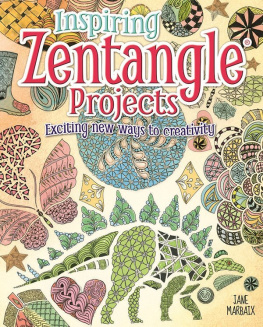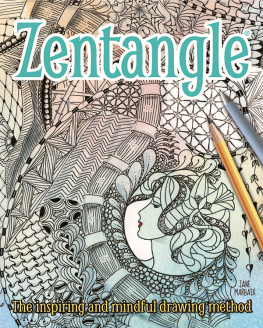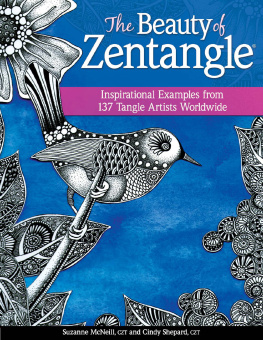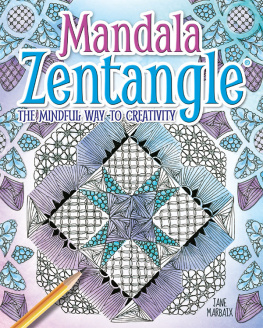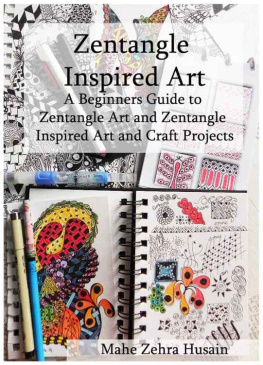Zentangle, the Zentangle logo, Anything is possible one stroke at a time, Bijou, Certified Zentangle Teacher, CZT, Zentangle Apprentice, and Zentomology are trademarks, service marks or certification marks of Rick Roberts, Maria Thomas, and/or Zentangle, Inc.
PERMISSION TO COPY ARTWORKS: The written instructions, designs, patterns and projects in this book are intended for the personal use of the reader and may be reproduced for that purpose only. Any other use, especially commercial use, is forbidden under law without the written permission of the copyright holder.
Dreamweaver stencils are available from www.woodware.co.uk and www.stampendous.com
All rights reserved. No part of this publication may be reproduced, stored in a retrieval system, or transmitted, in any form or by any means, electronic, mechanical, photocopying, recording or otherwise, without prior written permission in accordance with the provisions of the Copyright Act 1956 (as amended). Any person or persons who do any unauthorised act in relation to this publication may be liable to criminal prosecution and civil claims for damages.
INTRODUCTION
Our world is made up of patterns, whether in art, in nature or in the built environment yet you may not always have noticed them unless they are especially eye-catching and obvious. Once you learn the Zentangle Method of drawing, though, you will see them everywhere you look.
When I did my Certified Zentangle Teacher (CZT) training in the USA, I noticed that I and my colleagues were seeing patterns all around us as if our vision had suddenly become clearer. Today, I cant help finding patterns even in quite mundane surfaces such as floors, curtains and railings.
So what is Zentangle? In the words of Maria Thomas and Rick Roberts, the creators of this wonderful way of drawing, Zentangle is an easy-to-learn, relaxing and fun way to create beautiful images by drawing structured patterns. Its as simple as that!
Maria is a lettering and botanical artist, while Rick is a musician with many talents. He was a monk for 17 years, which enabled him to recognize that the calm and focused state Maria was in while she was doing her artwork was a form of meditation. From there, the couple set about finding a way to share this state of mind. Together with their daughter Molly Hollibaugh, they now hold seminars in Providence, Rhode Island for anyone interested in becoming a Certified Zentangle Teacher.
Can anyone tangle?
If you can hold a pen and make a dot, a line, a curve, a circle and an S-shape, then you can tangle. All you need is a couple of pens, a pencil, a paper stump for blending and a piece of paper and you can get started. The patterns, or tangles, are deconstructed into easy-to-follow steps, known as step-outs. On www.tanglepatterns.com, a website run by Linda Farmer CZT, you will find an amazing number of tangles for you to try.
To begin, draw a string a pencil line that divides your surface into sections. Then pick a tangle and fill one of the sections you have created. Continue by filling each section with a different tangle and thats it!
The Zentangle Method does not focus on the outcome that might be stressful if you have pre-conceived ideas about what your work will turn out like. Instead, as in life, the focus is on the journey, not the end result. So dont plan it, and dont feel the need to try hard just relax and see where it takes you! It is always a surprise when you see what you have created.
Tangling stills the mind and relieves stress, so its a good idea to keep a small sketchbook and a pen and pencil with you. Then, whenever you are kept waiting for an appointment, a train, a friend and so forth, you can take out your book and pen and start tangling, passing the time pleasantly rather than tapping your feet.
Like so many others all over the world, you will find Zentangle inspirational and it will increase your focus and creativity. This book is full of ideas and inspiring projects from many other CZTs worldwide. There are also contributions from people who are not CZTs I learn from my students as well. I hope that with the help of this book you will be able to train your mind towards relaxation and focus and you will create work so beautiful you will wonder how you achieved it.
If you wish to find a CZT in your area for some hands-on advice, go to www.zentangle.com and look under Learn More, where you will find a list of qualified teachers.
BASIC STEPS
Zentangle art is created on a tile, which is a 9cm (3in) square of paper or card. Using a good-quality surface such as Fabriano Tiepolo printmaking paper or a smooth watercolour paper will give you the best result. For drawing tools, I recommend a Sakura Pigma Micron 01 (0.25mm) pen, with an 08 (0.50 mm) pen for filling in darker areas. For pencil shading, use a 2B pencil as this soft grade can be easily blended using a paper stump (tortillion).
Creating a Zentangle design

Using your pencil, draw a dot in each corner of a tile.

Join up the dots lightly to form a frame. This can be straight or curved.
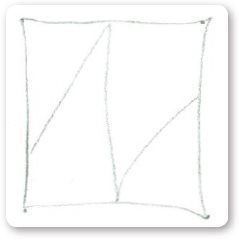
Next, draw a string. In this example it is in the shape of a Z, which forms four spaces.
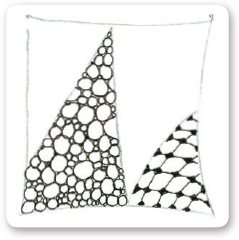
Draw a tangle in each space. Here I have done Tipple, a great tangle for filling in around other tangles. The other tangle is Florz created with a grid.
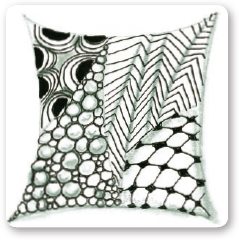
I completed the Zentangle with Crescent Moon, an example of a tangle with an aura (a line traced around the tangle), and Static, a fun tangle to shade as it becomes three-dimensional.
Changing your frame shape
You can create a very different look by changing the shape of your frame. The frame design below was created as a happy accident by Debbie Farnfield, one of my students, and I have copied her idea here.

Using a triangular string
On this tile we will use four different tangles Hollibaugh, Zander, Poke Root and Printemps. Step-outs for them can be found in the A-Z of tangles on .

